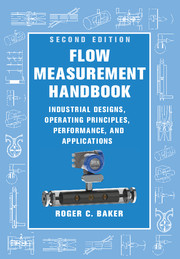Book contents
- Frontmatter
- Dedication
- Contents
- Preface
- Acknowledgements
- Nomenclature
- 1 Introduction
- 2 Fluid Mechanics Essentials
- 3 Specification, Selection and Audit
- 4 Calibration
- 5 Orifice Plate Meters
- 6 Venturi Meter and Standard Nozzles
- 7 Critical Flow Venturi Nozzle
- 8 Other Momentum-Sensing Meters
- 9 Positive Displacement Flowmeters
- 10 Turbine and Related Flowmeters
- 11 Vortex Shedding, Swirl and Fluidic Flowmeters
- 12 Electromagnetic Flowmeters
- 13 Magnetic Resonance Flowmeters
- 14 Ultrasonic Flowmeters
- 15 Acoustic and Sonar Flowmeters
- 16 Mass Flow Measurement Using Multiple Sensors for Single-Phase Flows
- 17 Multiphase Flowmeters 508
- 18 Thermal Flowmeters
- 19 Angular Momentum Devices
- 20 Coriolis Flowmeters
- 21 Probes for Local Velocity Measurement in Liquids and Gases
- 22 Verification and In Situ Methods for Checking Calibration
- 23 Remote Data Access Systems
- 24 Final Considerations
- References
- Main Index
- Flowmeter Index
- Flowmeter Application Index
9 - Positive Displacement Flowmeters
Published online by Cambridge University Press: 05 August 2016
- Frontmatter
- Dedication
- Contents
- Preface
- Acknowledgements
- Nomenclature
- 1 Introduction
- 2 Fluid Mechanics Essentials
- 3 Specification, Selection and Audit
- 4 Calibration
- 5 Orifice Plate Meters
- 6 Venturi Meter and Standard Nozzles
- 7 Critical Flow Venturi Nozzle
- 8 Other Momentum-Sensing Meters
- 9 Positive Displacement Flowmeters
- 10 Turbine and Related Flowmeters
- 11 Vortex Shedding, Swirl and Fluidic Flowmeters
- 12 Electromagnetic Flowmeters
- 13 Magnetic Resonance Flowmeters
- 14 Ultrasonic Flowmeters
- 15 Acoustic and Sonar Flowmeters
- 16 Mass Flow Measurement Using Multiple Sensors for Single-Phase Flows
- 17 Multiphase Flowmeters 508
- 18 Thermal Flowmeters
- 19 Angular Momentum Devices
- 20 Coriolis Flowmeters
- 21 Probes for Local Velocity Measurement in Liquids and Gases
- 22 Verification and In Situ Methods for Checking Calibration
- 23 Remote Data Access Systems
- 24 Final Considerations
- References
- Main Index
- Flowmeter Index
- Flowmeter Application Index
Summary
Introduction
The material in this chapter is based on the paper by Baker and Morris (1985) on positive displacement (PD) meters, which in turn has been updated with more recent industrial and published material and extended to gases. P. D. Baker's (1983) paper provided some additional useful information on these meters. The main types of liquid meter were given by Barnes (1982), Hendrix (1982), Henke (1955), and Gerrard (1979) (cf. Mankin 1955). The reader might refer to API (2005) and similar documents. Morton, Hutchings and Baker (2014a) provided additional references.
At least four of the meter designs to be discussed have been around for over 100 years. The nutating disc flowmeter for liquids was developed in 1850. The oscillating circular piston meter appeared in the late 19th century (Baker 1998).
The measurement of gas has depended, from an early date, on two types of positive displacement meter: the wet gas meter of high accuracy and credited to Samuel Clegg (1815), and the diaphragm meter of lower performance but greater range for which William Richards (1843) should take the credit and which has been widely adopted for the domestic gas metering market. The rotary PD gas meter appears to have shown good performance.
Background
The concept of carrying known volumes of fluid through a flowmeter is a short step from the use of a discrete measure such as a bucket or measuring flask. Thus in each of the designs described later, the flow enters a compartment that is as tightly sealed as is compatible with relative movement of adjacent components. A knowledge of how many of these compartments move through the flowmeter in one rotation of the shaft leads to a knowledge of the flow rate for a certain rotational speed. A simple theory is developed in Appendix 9.A.1. Clearly every leakage path will reduce or increase the amount carried and cause an uncertainty in the measurement. We can make an approximation of the leakage flows in the simple model. In addition, pressure and temperature will distort the volume and may cause small errors, and we may need to develop compensation for these.
- Type
- Chapter
- Information
- Flow Measurement HandbookIndustrial Designs, Operating Principles, Performance, and Applications, pp. 234 - 278Publisher: Cambridge University PressPrint publication year: 2016



